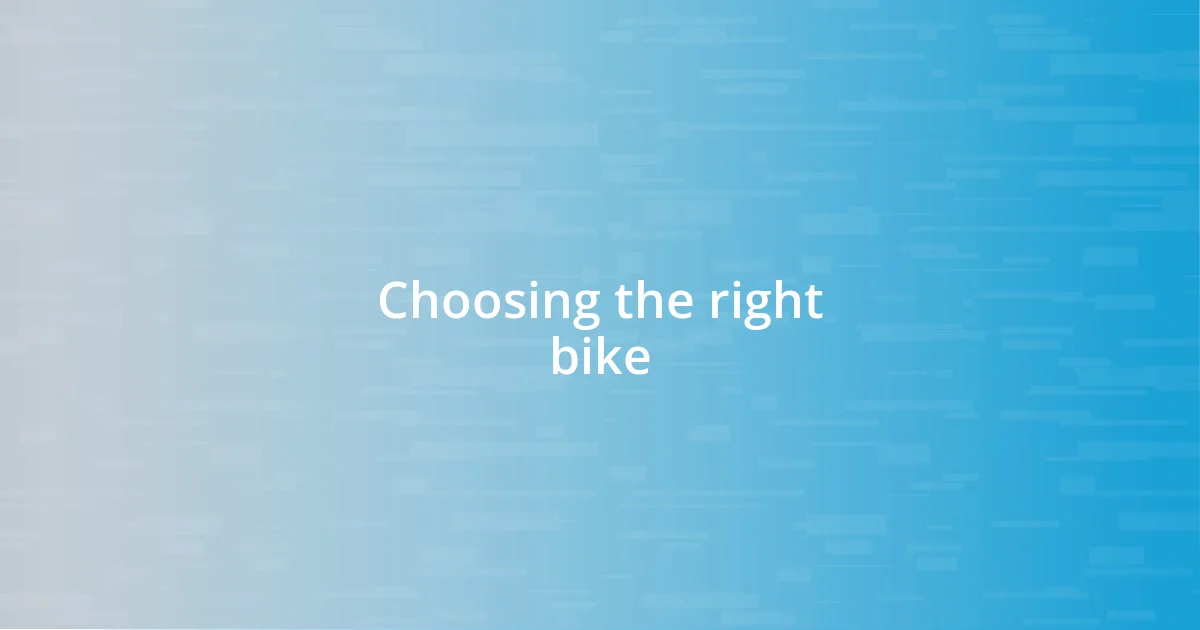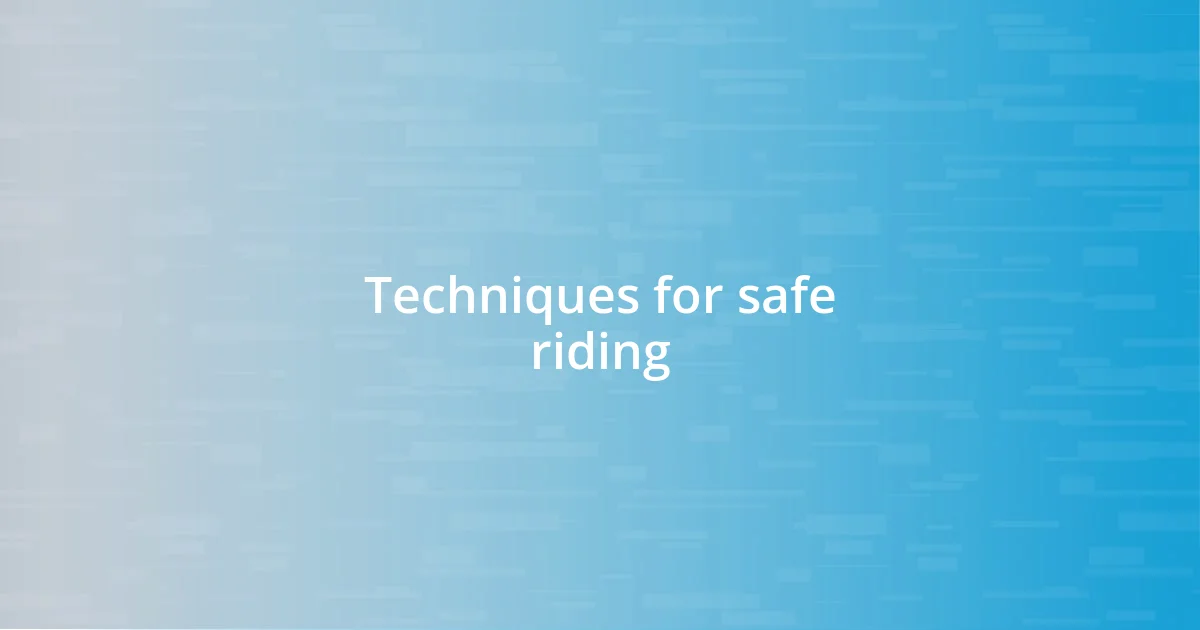Key takeaways:
- Understanding and following traffic rules is essential for safe biking, including the use of hand signals to communicate with other road users.
- Choosing the right bike and ensuring it fits well can greatly enhance safety and comfort while biking.
- Wearing proper safety gear, staying visible to drivers, and adapting riding techniques in adverse weather are crucial for avoiding accidents and ensuring a safe biking experience.

Understanding traffic rules
Understanding traffic rules is crucial for safe biking, as these rules are designed to protect everyone on the road. I remember a time when I was new to cycling in busy city streets. I thought I could zigzag through traffic like a pro, but I quickly realized that knowing when to stop at red lights or yield to pedestrians was key to avoiding accidents.
Sometimes, it feels overwhelming to remember all the signs and signals. Have you ever found yourself puzzled at a busy intersection? I certainly have. It was only when I made it a point to study the traffic signals in my neighborhood that I gained the confidence to navigate those tricky spots. Familiarity with these rules not only promotes safety but also enhances the overall biking experience.
Moreover, many cyclists underestimate the importance of hand signals or communicating with other road users. I learned this the hard way when I almost made a sudden turn without signaling. It’s a simple habit that can prevent confusion and help drivers anticipate your next moves. By taking the time to understand and apply traffic rules, we empower ourselves and foster a safer biking environment for everyone.

Choosing the right bike
Choosing the right bike can significantly affect your safety and comfort on the road. I remember my first bike; it was a flashy mountain bike that looked great but wasn’t ideal for city commuting. The moment I switched to a hybrid bike, everything changed. I felt more in control, and the smoother ride was both reassuring and enjoyable.
When assessing your options, consider what types of terrain you’ll primarily encounter. City riders, like myself, often benefit from a lightweight design that supports quick maneuvers in traffic. Meanwhile, cyclists who venture onto rougher paths might require sturdier tires and more robust frames. It’s all about finding the right balance that aligns with your biking lifestyle.
Lastly, don’t overlook the importance of fit. A bike that doesn’t fit you well can lead to discomfort or even accidents. I’ve experienced this first-hand; choosing a bike that felt just right transformed my cycling experience. Investing time in a proper fitting can make all the difference, ensuring you enjoy every ride while staying safe in traffic.
| Type of Bike | Best For |
|---|---|
| Hybrid | City commuting and casual rides |
| Mountain | Off-road adventures |
| Road | Long-distance rides and speed |

Essential safety gear for bikers
Essential safety gear for bikers
Wearing the right safety gear can truly be a lifesaver when biking in traffic. I’ll never forget one chilly morning when I reluctantly skipped my helmet while rushing out the door. That day, a car almost darted into my lane, and I felt my heart race—not just from the scare, but also from the realization of how vulnerable I was without that crucial piece of gear. Now, I never leave home without it. Proper gear not only protects you; it also boosts your confidence, allowing you to navigate traffic with greater peace of mind.
- Helmet: A well-fitted helmet reduces the risk of head injuries significantly.
- Reflective Vest: Wearing a reflective vest enhances your visibility, making it easier for drivers to see you at night.
- Gloves: Gloves improve grip and protect your hands in a fall.
- Knee and Elbow Pads: These provide cushioning during unexpected tumbles and bruises.
- Lights: Front and rear lights ensure you’re seen, especially in low-light conditions.
As I’ve learned through my biking journey, investing in quality safety gear isn’t just practical; it’s essential. One time, I rode with a friend who had knee pads, and we both took a spill during a sudden rainstorm. Thankfully, he walked away unscathed, while I had a few scuffs. That experience cemented my belief that the little things can make a huge difference in protecting ourselves. The right gear allows you to focus on the joy of biking, instead of worrying about what might happen if something goes wrong.

Techniques for safe riding
Riding safely in traffic involves mastering a few key techniques that have worked wonders for me. One crucial skill is anticipating the movements of others. When I’m cycling, I always keep my eyes scanning the road ahead—this means not just watching for cars, but also understanding the actions of pedestrians. Have you ever seen a driver make an unexpected turn? That moment of surprise can be avoided if you’re always one step ahead.
Another technique I swear by is maintaining a steady, confident line on the road. I remember a day when I felt nervous near an intersection. Instead of wobbly movements, I stood tall on my bike, signaling my intentions clearly. That day taught me the power of assertiveness. By positioning yourself confidently, you not only make it clear to drivers that you’re an experienced cyclist, but it can also deter risky behaviors from others.
Lastly, practicing effective braking can be a game-changer. I once had a close call when a car suddenly stopped in front of me. My heart raced as I squeezed the brakes—and thankfully, I stopped in time. That experience reminded me how essential it is to familiarize myself with my bike’s brakes before heading into heavy traffic. It’s not just about stopping; it’s about preparing for the unexpected, which can happen in a blink of an eye.

Staying visible to drivers
Staying visible to drivers is an essential part of safe biking, and I can’t stress enough how crucial it is to stand out on the road. One evening, I wore a bright orange jacket and rode home, and I genuinely felt the difference. Drivers seemed to notice me more, stopping at intersections and giving me ample room. Have you ever experienced the peace of mind that comes with visibility? It’s remarkable how a simple choice in gear can transform your ride.
Lighting plays a vital role in visibility too. I remember a night ride when I decided to leave my rear light behind, thinking it wouldn’t matter much. Just a few minutes in, I felt an uneasy tension as cars zipped past me. That’s when I realized how essential it is to ensure your lights are in working condition. A flashy, well-placed light can turn heads and catch the eyes of distracted drivers.
Lastly, it’s not just about wearing bright clothes or having lights. I’ve found that positioning my bike on the road can greatly enhance my visibility. When I ride further from the curb, I tend to get noticed better by cars merging in or out of lanes. It’s an uncomfortable thought, but have you ever wondered how easily drivers can overlook a cyclist tucked too close to the edge? Making small adjustments like this can be the difference between being seen and being a near miss.

Navigating intersections safely
Navigating intersections is often the most nerve-wracking part of a ride for me. I still remember a time when I approached a busy intersection; my heart raced as I approached the stop line. I make it a point to always look left, right, then left again—every time! It’s a simple practice, but have you ever noticed how easily your focus can wander? Those extra few seconds to check can be invaluable in avoiding a potential accident.
When I’m at a stoplight and the light turns green, I always take a moment to glance over my shoulder before moving forward. Just the other day, I was first in line when I spotted a car speeding through a red light in my peripheral vision. That split second saved me from what could have been a disaster. I learned that intersections have their own rhythm, and I need to play it smart. How often have you felt the rush of adrenaline as you decide when to move? It’s essential to be patient and let that instinct guide you.
Also, I’ve come to appreciate the power of hand signals—those little gestures can make a world of difference. I once had a fellow cyclist signal a left turn just before I approached an intersection. It gave me a clear understanding of their intentions, and I mirrored that behavior when making my own turns. Nothing brings a greater sense of camaraderie on the road than the shared responsibility of keeping each other safe. Have you felt the confidence that clear communication offers? For me, it truly transforms the experience of navigating through challenging zones.

Handling adverse weather conditions
When it comes to biking in adverse weather conditions, I’ve learned the hard way that preparation is key. One rainy day, I ventured out without proper gear and quickly found myself soaked and struggling to maintain control. That experience taught me to invest in a good rain jacket and waterproof pants, making all the difference on those unpredictable days. Have you ever felt the discomfort of being drenched while trying to ride? You don’t want your bike ride to feel like an uphill battle against the elements.
Visibility issues in fog or heavy rain can be daunting, but I’ve discovered that using reflective gear and bright colors is a game changer. On a particularly foggy morning, I noticed other cyclists didn’t seem to stand out, while I felt comforted by my vibrant vest. I could see their silhouettes, but I worried if they were even visible to passing cars. This goes to show how essential it is to be proactive—what steps can you take to improve your visibility on bad weather days?
Adapting my riding style during adverse weather is also crucial. I remember a day when I hit a patch of wet leaves and lost traction. Since then, I find myself slowing down, anticipating slippery spots, and avoiding sudden movements. The added caution pays off, allowing me to navigate through tricky conditions with much more confidence. Isn’t it amazing how shifting our approach can lead to a safer and more enjoyable ride, even in the rain?
















